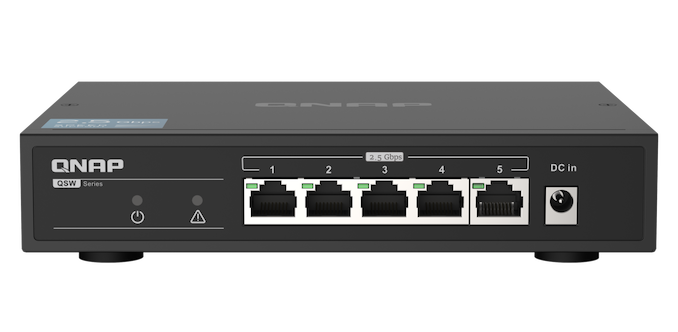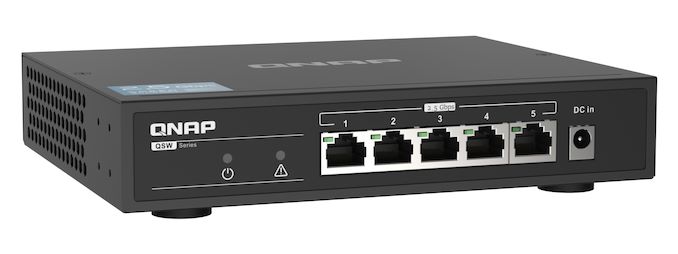At Last, a 2.5Gbps Consumer Network Switch: QNAP Releases QSW-1105-5T 5-Port Switch
by Ryan Smith on July 17, 2020 11:30 AM EST- Posted in
- Networking
- QNAP
- NBASE-T
- 2.5GBase-T
- Ethernet
- 2.5 GbE

After entirely too long of a delay, the wait for faster consumer-grade network switches appears to be coming to an end. This week QNAP launched its QSW-1105-5T switch, one of the industry’s first unmanaged 2.5Gbps (2.5GBASE-T) switches. The 5-port switch supports 2.5GbE operation on all five of its RJ45 Ethernet ports, and along with being unmanaged it is also fanless, allowing the switch to work maintenance-free and installed virtually anywhere. The QSW-1105-5T is already on sale in Taiwan for roughly $100, meaning that we’re looking at a price-per-port of about $20.
The saga of NBASE-T has been something of a long one. First introduced in 2016, the standard added the then-new 2.5GBASE-T and 5GBASE-T modes, which were designed to offer a series of intermediate steps between the existing 1Gbps (1000BASE-T) and 10Gbps (10GBASE-T) standards. By scaling down parts of the 10GBASE-T spec, the new standards would allow more modest – but still many times faster – network transmission rates than 1Gbps Ethernet, all the while being able to reuse existing Cat5e and Cat6 cabling. Overall, 2.5GBASE-T allows for 2.5Gbps Ethernet over Cat5e at the same 100m distances as 1Gbps Ethernet, while 5GBASE-T allows for 5Gbps speeds over 100m runs of Cat6, as well as quasi-official support for shorter Cat5e runs.
Given the technology reuse, moderately-priced NBASE-T network cards were quick to hit the market. However affordable switches have been a more complex matter: while the high initial price of NBASE-T was easy enough to eat on a single controller, multiplied over several ports on a switch, it quickly drove up the price tag. As a result, the market for NBASE-T switches has largely between split between downgraded pro gear like Netgear’s $70-per-port XS505M, and mixed-port switches like Asus’s XG-U2008, which offer just two 10G/NBASE-T ports along with a slew of Gigabit Ethernet ports. So cheap NBASE-T networking options have remained elusive, at least until now.
Thankfully, in the last year we’ve finally started seeing the slower of the NBASE-T modes, 2.5GBASE-T, sprint towards wide adoption. The 2.5Gbps standard is the cheapest to implement, and with recent controller releases from the likes of RealTek and Intel, 2.5Gbps controllers have quickly become a staple on high-end motherboards. Accordingly, with the price per port coming down for 2.5Gbps controllers, it’s also bringing down the price of whole switches. And this is where QNAP’s new switch comes in.
The QSW-1105-5T is one of the first switches to be released using these new generations of cheap controllers. Aimed squarely at the home and SMB markets, the switch doesn’t offer any frills such as network management, Power over Ethernet, or SFP+ ports. Instead it focuses on the things that matter for the home market: supporting 2.5Gbps networking in a small, passively-cooled switch that’s suitable to be neglected by being tucked under a desk or in a closet.
| QNAP QSW-1105-5T Switch | |
| Speeds | 100M/1G/2.5G |
| Ports (RJ45) | 5 |
| Managed | No |
| Power | 12 W |
| Dimensions | 3.4 x 18 x 14.5 cm |
| Cooling | Passive (Fanless) |
| Price | ~$100 |
As the first of what will undoubtedly be many 2.5G switches over the coming months, the QSW-1105-5T also gives us our first real look at what we can expect from this generation of switches as far as footprints and power consumption goes. Since it’s not carved from a pro-grade switch, the 18 cm x 14.5 cm switch is significantly smaller than earlier NBASE-T switches. And with a maximum power consumption rating of 12 W, we’re looking at power consumption of just a bit over 2 Watts per port, which is also a significant improvement over admittedly far more powerful switches.
All of which sounds unremarkable, and indeed that’s exactly what makes the QSW-1105-5T so interesting. The biggest barrier to wide consumer adoption over the last few years has been the cost – both in regards to the core technology and added frills – so we’ve been waiting for quite a while to see NBASE-T technology transition from pro-grade switches to cheap, consumer-grade gear.
Otherwise, QNAP’s new switch is further evidence that the PC industry is going to coalesce around 2.5Gbps Ethernet for the time being. Besides being the fastest standard to officially and fully support Cat5e cabling – which was installed in walls en masse when home networking first took off – it’s also the cheapest and lowest-power option. This is allowing it to be widely deployed not only in new motherboards and cheap USB adapters, but finally in switches as well – and making QNAP’s new switch a good match for all of those new NICs. And while I’d like to see cheaper 5Gbps and 10Gbps gear as well, 5GBASE-T seems likely to remain a premium (if not niche) option, owing to the higher controller costs as well as its higher power consumption, both of which remain big problems for a switch.
At any rate, QNAP’s 2.5Gbps switch is on sale now in Taiwan. The company has not announced release dates elsewhere, but judging from some of their previous product releases, I’d expect it to start showing up in North America some time in the next few months.
Source: QNAP

















98 Comments
View All Comments
DanNeely - Friday, July 17, 2020 - link
This looks like a good first step, I'd really like to be able to go directly to 10gb in about 2 years when I build my new box though.romrunning - Friday, July 17, 2020 - link
I'd like 10/5/2.5/1GBe controllers to be standard, especially on ITX boards where you don't have an additional slot for a separate NIC. Something like the Intel X550-AT would work.CaptainChaos - Friday, July 17, 2020 - link
Be aware that Intel currently specs the X550-AT to support NBASE-T under Linux only for some reason!friedpenguin - Wednesday, July 29, 2020 - link
This is a problem how? :)twtech - Friday, July 17, 2020 - link
We have 10G NICs already, it seems strange that it's still so hard to get the other parts of the hardware.Shawn_Hicks - Saturday, July 18, 2020 - link
The cabling standard requirement for 10Gbe only are higher. The 2.5/5Gbe speeds are intended to accommodate older cable plants that can't support 10Gbe but faster than 1Gbe. If you're already wired for 10Gbe, you'd use a 10Gbe switch. If you have an older spec cable that supported 1Gbe, then there was no motivation to transition to 10Gbe. The new options allow transition to better performance where it's needed without recabling, a nieche for enterprise environments.AnarchoPrimitiv - Friday, July 17, 2020 - link
I suppose the 2.5Gbe NICs on Z490 boards finally aren't a marketing gimmick. Seriously though, I don't understand why 2.5Gbe is being pushed in the consumer space instead of at least 5gbe. SATAIII SSDs are ubiquitous at this point and I would imagine a 5GBase-T switch would be basically the same cost as 2.5GBase-T as you can now buy brand new 10GBase-T switches for $200 or less. 10GBase-T should be what is pushed next considering the fact that you can buy a 1TB NVMe SSD for literally the same price as a 1TB SATAIII SSD.I know many people are going to say they don't need 10Gbe in their home, but once you have the capability, you find a use for it, like I have with the 10GBase-T network in my home (my server/NAS can easily do multiple 4K Blu ray rip streams (with any necessary transcoding without breaking a sweat)
senttoschool - Friday, July 17, 2020 - link
It's not hard to understand.2.5Gbe is here because WiFi 6 can exceed 1Gbps, Cate5e installations are common and does not always support 10Gbe, and home internet connections that is faster than 1Gbps will be possible in the near future. 5Gbpe will be pretty common fairly soon is my assymption.
10Gbe is only useful right now for homes if have an internal NAS/need to transfer a lot of data on your network. 99.99% of home networks don't need that. "Normal" people don't have home servers and NAS. And those that do can afford 10Gbe.
You need to step outside of your enthusiast mindset. Once you do, it's really easy to understand why 10Gbps isn't being pushed to homes.
Makaveli - Friday, July 17, 2020 - link
Near future depends on where you are I guess.The ISP I'm on has offered 1.5Gbps Connections since around August 2018. They did mention plans of going 5Gbpe down the road.I do agree use case will be different for normal people vs enthusiast.PeachNCream - Friday, July 17, 2020 - link
Meanwhile, my choices are 10Mbps DSL or 56k on POTS. No provider is interested in building out infrastructure the last few miles to get decent bandwidth to my home yet I'm less than 14 miles outside of a community with a population of 50k people.